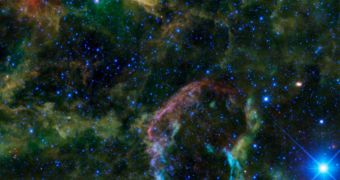A new astronomical investigation carried out with a NASA telescope has revealed the existence of a circular, rainbow-like structure around the remnants of a star that exploded fairly recently.
As the massive star reached the end of its burning cycle, it shed the external layers of its atmosphere in a massive cosmic explosion known as a supernova.
The event, which most likely took place between 5,000 and 10,000 years ago, produced the nebula IC 443, which was the target of the new investigations.
The team that conducted the research used the American space agency's Wide-field Infrared Survey Explorer (WISE) to look at the nebula. The telescope observes the Universe in infrared wavelengths.
One of the things that supernovae do when they explode is produce tremendously powerful shock waves, which spread out in their surroundings, heating up all cosmic dust and hydrogen gas they find.
The ensuing structure is called a supernova remnant, and IC 443 is a wonderful example of such a cosmic object. The WISE image shows that densities of the gases that were affected by the supernova shock waves.
Experts explain that different gases release infrared light on different wavelengths, in tune with how dense they were before the massive star blew up next to them.
This particular remnant features a smaller southern shell, which is depicted in the new WISE image in bright, bluish colors. The shock waves that produced it most likely traveled fairly slow, at around 30 kilometers per second, or 67,100 miles per hour.
The greenish dust cloud that can be seen cutting across the supernova remnant from a northwest to southeast direction is a dense cloud located nearby, which also experiences the long-term effects of the shock waves.
IC 443 can be found near the star Eta Geminorum, which lies near Castor, one of the twins in the constellation Gemini. The triple star system is located an estimated 350 light-years away from our Sun.
WISE is one of the newest NASA telescopes. It was launched on December 14, 2009, and is designed to act as a replacement for the Wide Field Infrared Explorer (WIRE) mission, which failed in 1999.
The mission is managed for the NASA Science Mission Directorate, in Washington, DC, by experts at the Jet Propulsion Laboratory (JPL), in Pasadena, California.
The lab is in turn manged by the California Institute of Technology (Caltech).

 14 DAY TRIAL //
14 DAY TRIAL //